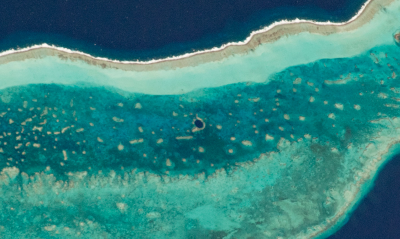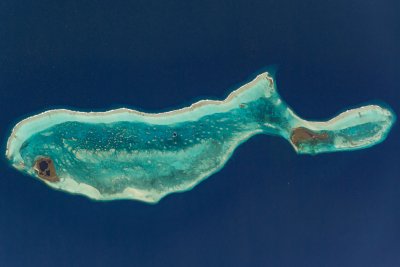The Great Blue Hole off the coast of Belize has been photographed from space, with an astronaut onboard the International Space Station taking an image of it and the Lighthouse Reef atoll it sits in.
The image was taken by a member of the Expedition 62 crew as the ISS flew over the Caribbean Sea in March. It was released by NASA as its Earth Observatory Image of the Day.
Also known as the Great Blue Hole, the submarine sinkhole is around 1,000 feet wide and 400 feet deep, making it the largest in the world. It is located around 50 miles from the coast of Belize and was made famous in the 1970s after Jacques Cousteau visited and said it was one of the top diving sites in the world.



The hole is thought to have formed hundreds of thousands of years ago, when sea levels were far lower than they are today, as a limestone cave. When the last ice age came to an end, sea levels rose and the cave was submerged.
NASA Earth Observatory says that while life is abundant around the Lighthouse Reef, the lack of light and poor circulation of oxygen at the bottom of the Great Blue Home means little can survive.
Until recently, the deepest points of the hole had been relatively unexplored. In 2018, a team including Richard Branson and Fabien Cousteau—the grandson of Jacques—went on an expedition to the bottom of the hole to create a 3D view of its interior. In an interview with Newsweek last year, National Geographic explorer and submarine pilot Erika Bergman, who took part in the dives, explained what they found below the hydrogen sulfate layer—beneath which there is no oxygen.
"Without oxygen, nothing survives," she said. "Beneath the hydrogen sulfide layer it is very dark. Looking straight up from inside the submarine you can just barely make out the circular opening of the hole, all of the light pouring into the hole is shut out by the thick chemical layer."
Understanding life inside blue holes is part of an ongoing mission by the National Oceanic and Atmospheric Administration (NOAA). Last year, scientists investigated the Amberjack Hole off the coast of Florida, measuring nutrients and compounds at the bottom, as well as taking core samples.
"A blue hole can be an oasis in an otherwise barren seafloor. Blue holes are diverse biological communities full of marine life, including corals, sponges, mollusks, sea turtles, sharks, and more," the NOAA said. "The seawater chemistry in the holes is unique and appears to interact with groundwater and possibly aquifer layers. This link contributes to the knowledge of carbon cycling between surface and groundwater.
Earlier this month, the team started exploring a second site, known as the Green Banana, using the same techniques. Another dive is scheduled for May 2021. This deeper blue hole extends to 425 feet and is hourglass-shaped, the NOAA said.
From these dives, the team hopes to find out if the sinkholes are connected to Florida's groundwater, whether they are secreting nutrients—and whether these "microenvironments harbor unique or new species of microbes."
Uncommon Knowledge
Newsweek is committed to challenging conventional wisdom and finding connections in the search for common ground.
Newsweek is committed to challenging conventional wisdom and finding connections in the search for common ground.
About the writer
Hannah Osborne is Nesweek's Science Editor, based in London, UK. Hannah joined Newsweek in 2017 from IBTimes UK. She is ... Read more
To read how Newsweek uses AI as a newsroom tool, Click here.








